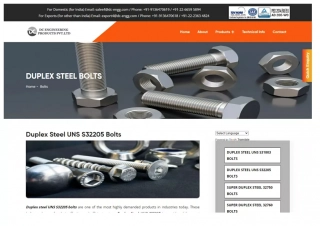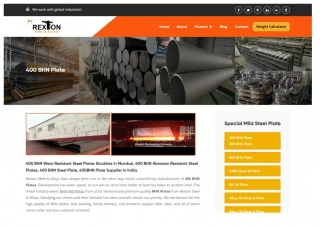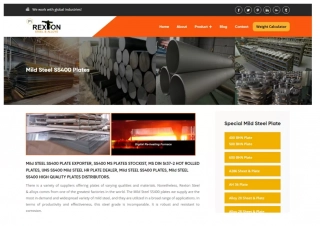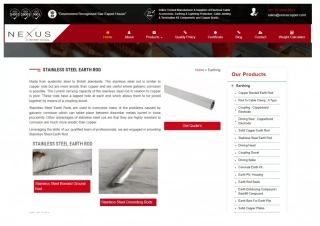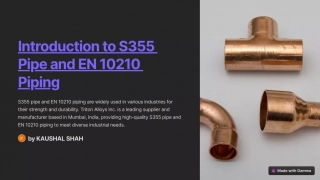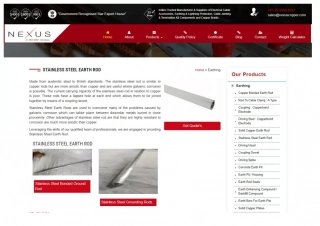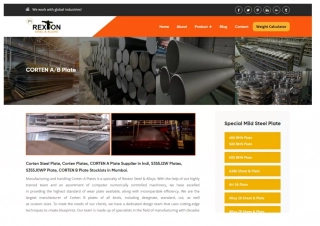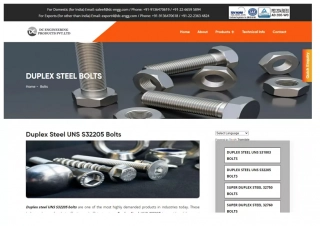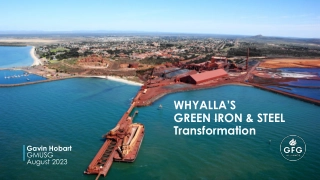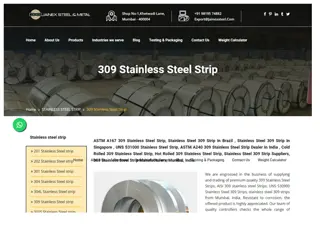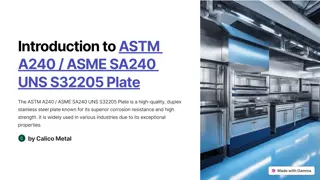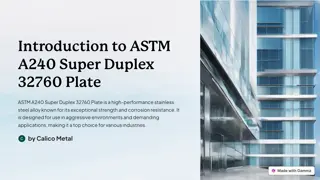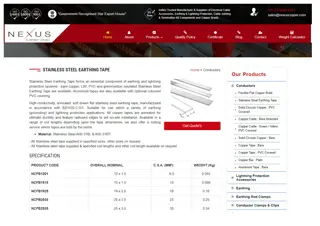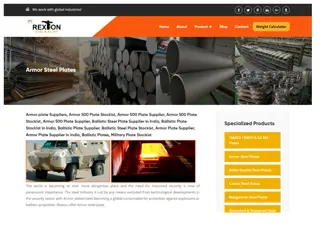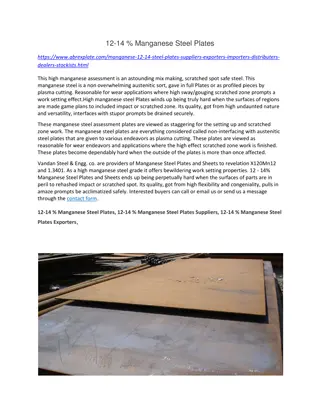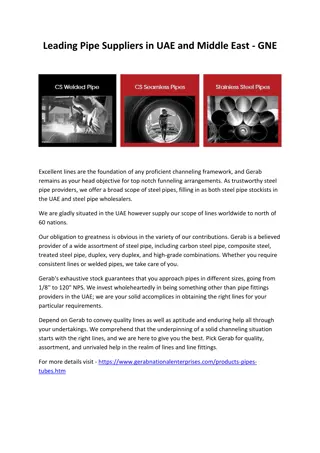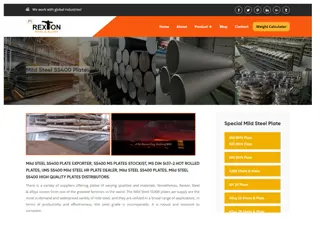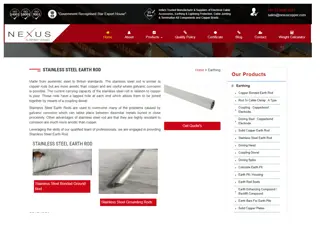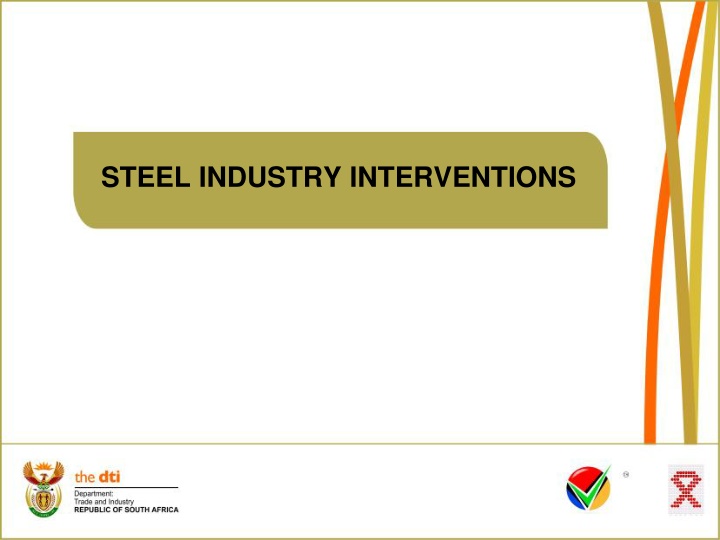
Global Steel Industry Challenges and Interventions
The steel industry is facing structural challenges with oversupply and high production costs. Various policy interventions are being implemented to support the sector amidst declining global demand and massive overcapacity, particularly from China. This challenging environment is impacting the entire steel value chain, posing obstacles for iron-ore mines, primary steel mills, and manufacturers to remain competitive and sustainable.
Download Presentation

Please find below an Image/Link to download the presentation.
The content on the website is provided AS IS for your information and personal use only. It may not be sold, licensed, or shared on other websites without obtaining consent from the author. If you encounter any issues during the download, it is possible that the publisher has removed the file from their server.
You are allowed to download the files provided on this website for personal or commercial use, subject to the condition that they are used lawfully. All files are the property of their respective owners.
The content on the website is provided AS IS for your information and personal use only. It may not be sold, licensed, or shared on other websites without obtaining consent from the author.
E N D
Presentation Transcript
CONTENT 1. CONTEXT 2. GLOBAL OVERSUPPY 3. STRUCTURAL CHALLENGES (HIGH STEEL PRODUCTION COSTS) 4. STRATEGIC IMPORTANCE OF STEEL SECTOR 5. STEEL OUTLOOK FOR SA 6. POLICY INTERVENTIONS 7. PRIMARY STEEL TARIFF SUPPORT AND COMMITMENTS 8. STEEL COMMITTEE 9. INVESTMENT COMMITMENTS 10. KEY INVESTMENT ISSUES (SALDANHA, HIGHVELD, CISCO) 11. FOUNDRIES 12. DOWNSTREAM SUPPORT MEASURES (TARIFF REVIEW AND REBATES) 13. LOCAL PROCUREMENT AND DESIGNATIONS 14. PRICING PRINCIPLES 15. COMPETITION COMMISSION SETTLEMENT WITH AMSA
CONTEXT The global economic environment remains difficult for resource based economies with sharply lower commodity prices a reflection of a decline in global demand but also of over supply by major producers Many emerging market currencies exposed to lower growth prospects and subdued commodity prices have seen the sharpest falls The steel industry has been particularly hard hit - oversupply and massive installed capacity in China has seen a number of countries deploying a range of measures to protect steel production capacity Governments around the world are grappling with the steel crisis Forecasts predict that an oversupply (currently at 400 mtons/annum) will remain for some time due to China s massive over capacity as well as the declining global demand. China accounts for 50% of global steel production.
GLOBAL OVERSUPPLY Nominal capacity1 Production @ 85% capacity utilization Outlook Global overcapacity1is estimated at ~400 mtpa crude steel 2004 2008 demand and supply were closely matched Plant utilization to stay below 80% for the next few years Global overcapacity has been steadily increasing 2 500 2 000 1 500 mtpa 1 000 Global demand 500 0 2004 05 06 07 08 09 10 11 12 13 14 15 16 17 18 19 2020 1Overcapacity = (crude steel capacity* 85% capacity utilization) crude steel apparent demand 2 Based on Nominal capacity Source: Mckinsey, World steel association base case scenario
STRUCTURAL CHALLENGES The effects of the depressed global steel market are evident across the value chain as the iron-ore mines, primary steel mills & domestic manufacturers struggle to compete, sustain jobs and invest The situation is exacerbated by SA s high steel production costs & administered prices Aged plants and inefficiencies - lack of investment and maintenance Energy - electricity and gas price increases (>300% and 160% since 2007) Transport - increasing rail tariffs (>100% increase since 2007), uncompetitive port charges and inefficiencies on domestic vs export lines (Sishen-Van der Byl), AMSA additional road transportation costs for 2016 @R731m Costs: 40% transport, electricity and wages dollar based inputs (iron-ore, coking coal) Given the above structural challenges and indications that the existing slump is likely to continue, the need for a steel industry in SA is often debated when there is a high price tag associated with both support and any future significant structural reform.
STRATEGIC IMPORTANCE Why do we need a steel industry in SA? Steel is fundamental to manufacturing in SA accounting for significant value add and representing 190 000 jobs in the direct iron-ore, steel making and fabrication industries. Top steel consuming industries (mining, construction, autos, cables, structural steel) contribute ~R600bn to SA s GDP (~15%) and employ ~8m people (direct and indirect) The loss of SA s primary steel production capacity (and becoming an exporter of iron ore and an importer of steel) will leave SA at the mercy of the global steel market in the long run and preclude SA from utilizing its comparative resource endowment advantage In our view, the sustainability and future existence of the sector as a whole (both upstream and downstream) is integral to achieve the country s economic development goals and support the growth of key sectors. 6
OUTLOOK FOR SA Despite the current challenges, there are opportunities and strengths for a sustainable, competitive steel sector: There is a positive correlation between GDP and steel intensity for developing countries. SA and countries in the region are low down on the steel consumption curve with forecasts that this is likely to increase with economic growth SA has the only primary steel mill in SSA and with Egypt are the only producers in the region representing a huge opportunity to supply steel and steel products to neighbouring economies, many of which are growing at about 5% or more per annum. Significant infrastructure expansion and construction activity will take place on the continent and within SADC over the next decade, creating demand for steel products Export growth in structural steel to other African countries and global mining regions (Australia, S America) Significant capabilities, skill and capacity of the local steel construction industry to supply the infrastructure program, mining & oil and gas 7
POLICY INTERVENTIONS Over the last 18 months since the slump began to take effect, the Inter- Departmental Task Team on iron and steel has been working on a number of demand side measures to support and save the industry from the immediate threats of closure and the subsequent loss of capacity. Task team also looking at long term policy, programme and project interventions to arrive at an optimal end state of a viable, competitive and sustainable steel industry in SA balancing the interests and support for both upstream and downstream
MEASURES Package of interventions to ensure the sustainability of the steel industry is based on the following initiatives: 1. An increase in tariffs for primary steel products within the policy parameters and due processes 2. Downstream support measures including tariff review and deployment of rebates subject to policy and due process 3. Agreement on a set of principles for flat steel pricing in SA that is priced appropriately to ensure that steel-dependent industries are competitive while at the same time ensuring that the upstream steel mills remain sustainable 4. Increase of local procurement by government in the infrastructure programmes 5. Settlement of the Competition Commission issues with AMSA
PRIMARY STEEL SUPPORT & COMMITMENTS TARIFFS Increase in the rate of customs duty to 10% implemented for 10 primary steel products galvanised, coated/painted steel (September 2015) wire rod, rebar and structural steel (Dec 2015) semi-finished steel, steel plates, cold-rolled steel and steel sections (Feb 2016) hot rolled coil and other rods, bars and forges (June 2016) TARIFF COMMITMENTS 1. Investment and improving competitiveness in product lines for key economic sectors (technology, equipment upgrades, skills) 2. Job creation and job retention 3. Pricing remedy and an agreement on a suitable pricing model with government 4. Industrial output
STEEL COMMITTEE The Steel Committee has been established under Section 14 of the ITA Act on 10 June 2016. The committee members consist of ITAC Commissioners and representation from the primary and downstream industries: Representative Association Mr. Johann Nel South African Iron and Steel Institute (SAISI) Mr. Paolo Trinchero Southern African Institute of Steel Construction (SAISC) Mr Gerhard Papenfus National Employers Association of South Africa (NEASA) Mr Dean Subramanian Arcelor Mittal South Africa (AMSA) Mr Tafadzwa Chibanguza Steel and Engineering Industries Federation of Southern Africa (SEIFSA) Mr Neels van Niekerk International Steel Fabricators (ISF) Mr Raghu Ram South African Coil Coaters Association The dti and EDD officials are invited to meetings to provide technical support and advice to the Committee
STEEL COMMITTEE The roles and responsibilities of the Committee include monitoring and evaluating the performance of the primary steel industry against the set reciprocal commitments including pricing, equipment upgrading, technology, production and employment steel pricing for all steel products using the basket pricing methodology for flat steel the performance with regard to new investments and growth, ensuring both the short and long term viability of the primary producers as well as the downstream steel fabricating industry import and export trends relevant to the steel industry value chain; and the preparation of reports with recommendations to the Commission at least bi-annually.
INVESTMENT COMMITMENTS Capex (Rm) 10 280 90 460 Volume (ktpa) 18 100 200 230 Date Product Line Project Increase colour line capacity Install new colour line Install additional ladle furnace Convert continuous annealing to galv 2016 2016 2015 2016 Appliance Appliance/Roofing, Cladding Automotive/Construction Develop double reduced tinplate Reline of Corex/Midrex at Saldanha 200 1050 100 170 2015-16 2016* Packaging Primary steel making New coke oven battery at Vanderbijlpark 2550 n/a 2016-18 Primary steel making Total 4640 * Delayed for 3 years, mini reline underway
KEY INVESTMENT ISSUES VEREENIGING AND HIGHVELD AMSA are in the process of restarting the: Vereeniging Melt shop (specialised long steel) Highveld Heavy Structural Mill (with the IDC). Heavy sections that were produced by Highveld in the past are all currently being imported. Retention of 300 jobs that were lost due to Highveld closure CAPE TOWN IRON AND STEEL WORKS In light of recent duties and designations Cisco are ready to re-start the long steel plant Significant investment, technology and efficiency upgrades complete and planned employment of 500 people Preliminary 12i Tax Incentive approval Measures to support better access to domestic scrap metal will be critical. Challenges with current Price Preference System National Treasury have developed guidelines for export tax applications
KEY ISSUES: FOUNDRIES Current Status Approximately 170 foundries operating in the formal sector (2015) , output of ~374 000t (2015) Employs 13 000 employees (9000 direct; 4000 indirect) Serious capacity decline since 2010 (25 foundries closed; 1700 jobs lost) In 2015/16 , 9 foundries closed and 635 direct jobs lost Three foundries have applied for business rescue interventions (2016) Challenges Costs (scrap, energy and labour). Price of foundry grade scrap has increased by 28% since Jan 2016. Compliance with the environmental legislation: Air Emissions license fees, fines Require stronger response to the localisation policy by SOC s Skills Development, ageing equipment and technology Accreditation (only 1/3 are internationally accredited limiting participation in global supply chains)
DOWNSTREAM SUPPORT MEASURES TARIFF REVIEW the dti requested ITAC to lead a proactive investigation and review of downstream tariffs ITAC are working with industry through the associations, surveys including targeted workshops/roadshows to compile the required information. The following product groups are targeted for the Phase 1 investigation: Tubes and pipe fittings Structures Wire and wire products Screws, bolts and nuts Gas stoves Refrigerators Base metal mountings Washing and drying machines Transformers Fully built up locomotives Rail parts
DOWNSTREAM SUPPORT MEASURES REBATES 1. Rebates 470.03/521.00 (full waiver or refund) on the customs duty on imported steel used in the manufacture of goods exclusively for export. This rebate is readily available and can be issued within 10 days. Rebate being taken up by re- rollers who export large portion of production. 2. Schedule 3 and 4 rebates (full waiver) on the customs duty on imported steel or steel products that attract duties but are not produced or insufficiently produced domestically and therefore allowing manufacturers to source their intermediate material and component inputs at world prices. Rebate determined on a case by case basis upon application. Autos and appliance sector are applying. 3. ITAC are working on the creation of a Schedule 4 rebate for HRC and plate. The creation of a dedicated rebate provision will allow for efficient implementation in the event of shortages in the market.
LOCAL PROCUREMENT:PRIMARY AND DOWNSTREAM Both primary and downstream have raised the need for increased local demand to drive economies of scale and relieve price and cost pressures 1. 2. Primary producers have requested government to reconsider public procurement of locally manufactured primary steel as input into current and future designated steel products. 3. Steel crisis led to the review of the deeming of steel as one of the measures to support the industry and protect jobs 4. Revised instruction notes for the undeeming of primary steel published by National Treasury for 7 designated products in July (two way radio terminals , photovoltaic systems and components , solar water heaters, rail rolling stock , cables, conveyance pipes, working vessels, steel power pylons) 5. Additional designations of steel construction materials are being considered to support the downstream job intensive steel sectors including: fabricated structural steel wire products roofing and cladding ducting and structural pipework, gutters, downpipes and launders frames fasteners, joining and connecting components
STEEL PRICING PRINCIPLES The Fair Pricing Principles to be agreed between the parties (AMSA and government) Import Parity Pricing (IPP) will be removed as a basis for pricing The pricing principles will exclude long products.(unless specifically stated) The local price for flat steel products will be based on an import weighted basket (excluding China & Russia) (note A), determined by the weighted average of countries we compete with This will be based on primary data from the CRU and MEPS global steel indices and: agreed upon benchmarked deltas (note B) will then be added on to the hot rolled coil base price to calculate base prices for other flat steel products; and agreed upon averages (not exceeding 11% overall) will be used to calculate extras . When AMSA reviews it s flat steel pricing, it will be done using a transparent mechanism based on forecast basket prices using the latest CRU published prices, where available, and the R/USD exchange rate, assuming a 1 month forward. The announced and published price will include the settlement discount, currently 2,5%. Quarterly monitoring of the import weighted basket, and compliance with the pricing mechanism for all flat steel products will be the responsibility of the steel committee under the auspices of ITAC.AMSA s published pricing will be reviewed based on actuals for the preceding quarter. The overall EBIT margin cap to be imposed will have the effect of ensuring that the benefits of iron-ore pricing will result in a benefit to AMSA s customers and the downstream. 19
STEEL PRICING NOTE A Weighted average based on the domestic steel price in countries (excluding China and Russia) we compete with in following steel intensive downstream sectors/sub sectors 1. fabricated metal products 2. machinery and equipment 3. vehicles and other transport equipment Basket countries are: EU 50% - 50% Germany, 50% (France, UK, Italy, Spain) Asia 30% - 50% Japan, 40% (South Korea and India), 10% Taiwan NAFTA plus Brazil 20% - 75% USA, 25% (Canada and Brazil) NOTE B Products Hot Rolled Plate Cold Rolled Coil Galvanised Coil Colour Coated Coil Deltas over HRC Base Price USD 99/t USD 95/t USD 177/t USD 472/t 20
STEEL INTENSIVE IMPORTS 70% Basket Country weightings determined by percentage of steel intensive imports from each region (Excluding China) European Union 60% Asia Nafta + Brazil 50% Other 40% 30% 20% 10% 0% Source: Quantec data 21
STEEL PRICING Basket aims to provide a fair price (during boom and bust periods) and in its absence import parity pricing will prevail Close correlation between basket and AMSA prices from early 2015 as slump began to take effect Global market prices have increased since Feb 2016 as many countries introduced tariff and other measures, increased input costs Prices have come down since June, (AMSA reduced prices in July according to basket), global prices will be flat for the medium term 22
COMPETITION COMMISSION SETTLEMENT The Commission has reached a settlement agreement covering all cases against AMSA, filed with the Tribunal on 22 August 2016 for confirmation Agreed Terms of Settlement: AMSA admits having been involved in the long steel and scrap metal cartels, and agrees to pay an administrative penalty of R1.5 billion in five annual instalments of no less than R300 million AMSA has agreed to remedies relating to complaints against its pricing conduct: AMSA has undertaken that for a period of five years it will limit its EBIT (earnings before interest and tax) margin to a cap of 10% for flat steel products sold in SA. The 10% margin cap is subject to variation up to a maximum of 15% subject to certain market circumstances as set out in the agreement AMSA has committed to a R4.6bn capital expenditure over the next five years
CONCLUDING REMARKS Given the current severe challenges, the future of SA s steel sector depends on a holistic solution underpinned by interventions that are designed to ensure a sustainable primary steel industry whilst supporting the downstream industry Key objectives is to stimulate the economy, generate exports and create employment Sustaining a competitive local steel producing capacity and capability will be a significant advantage in contributing to economic growth and infrastructure development in a cost effective manner Support for the value added, labour intensive downstream industry remains a priority and imperative of government The key outcome is the optimal end state of a viable, competitive and sustainable steel industry in SA
THANK YOU QUESTIONS & COMMENTS 25

